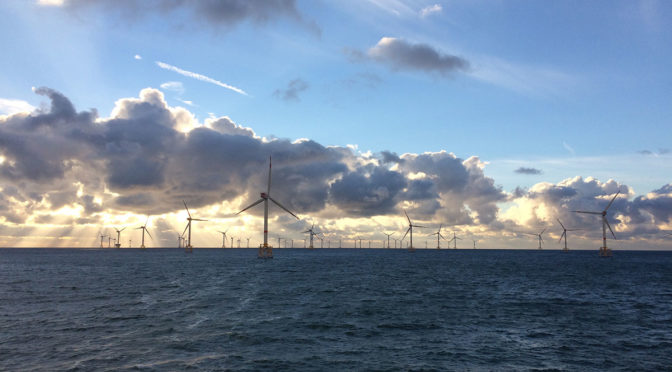Poland’s largest power group PGE has abandoned its leading role in plans to build the country’s first nuclear power station as it focuses on new wind farms in the Baltic Sea.
State-controlled PGE announced a nearly $10 billion offshore wind project in March but has also been responsible for the nuclear project.
Both plans are part of a major change in Polish policy. Coal mining provides around 80 percent of its energy and thousands of jobs but makes it one of Europe’s biggest polluters.
The government promised to defend coal from competition but has been forced to look for alternatives to fill an electricity shortfall and to meet European Union emissions targets.
One source said PGE could not fund both projects and cheap technology had swung the decision in favour of wind. PGE could still play a smaller role in the nuclear project which has been delayed and still needs government approval.
“PGE cannot afford both — offshore wind and nuclear. The decision was taken to go for offshore,” the source said.
A government source also said that PGE would focus on offshore. A spokesmen for PGE declined to comment.
Asked whether it could take the project on, PKN Orlen’s press office said in an emailed statement that the company “continuously analyses a number of different projects that could be part of the long-term development plans of the group.”
Poland’s ruling conservative Law and Justice (PiS) party promised before elections in 2015 to defend the coal industry and put in place laws to prevent new investment in both onshore and offshore windfarms.
But in March it changed tack and proposed a law to make it easier to build wind turbines. That is currently being debated in parliament.
If the law is passed, as expected, several other wind farm projects could also proceed.
Polenergia, owned by the Kulczyk family, has said it would like to build a wind farm in the Baltic by 2022. PKN Orlen is also considering building one.
PGE said in March that it wants to build offshore windfarms with a capacity of 2.5 gigawatts (GW) by 2030.
PGE did not say how this would be financed. The state owns 57.39 percent and there are over a hundred other small shareholders, according to Thomson Reuters Eikon data.
The group’s cash amounted to 2.5 billion zlotys ($712.92 million) at the end of 2017. It could issue more bonds as part of its 2 billion euros and 5 billion zlotys bond programs.
Subsidy question
Analysts and investors say that offshore wind farms are the easiest and fastest way for Poland to fill the expected capacity gap from coal and reduce carbon dioxide emissions in line with the EU’s 2030 targets as Poland seeks improved ties with Brussels.
They provide more electricity than onshore windfarms, which Poland already has, and can be built more quickly than a nuclear power plant.
The decision to open up the offshore power industry could also draw in investors. Statoil said in April it would join Polenergia’s offshore project which has drawn interest from other international wind companies.
“We received phone calls from all over Europe after Statoil’s decision was announced. If such a player has entered, we need to be in too, many investors say,” said Maciej Stryjecki, the president of the board at SMDI Advisory Group.
Some investors will also be waiting to see if Poland offers subsidies in cash or payments for getting connected to the grid.
“Even if we take into account the very positive trend in the decline in offshore technology costs, offshore wind farms will not be built without support,” said Michal Michalski, Polenergia management board member.
The government’s official position on this is not clear. Officials in the energy ministry were not available to comment.
The PiS minister responsible for Poland’s power and gas infrastructure, who reports directly to the prime minister, said companies should not need such incentives.
“We expect that offshore windfarms will be built without support, but the falling cost trend is very encouraging,” Piotr Naimski told Reuters.
He has been a strong advocate of coal but said offshore would be a part of Poland’s energy mix in 2025-30.
Emotional issue
Reducing the dependence on coal is an emotional issue in Poland. The coal industry still employs 83,000 people and some are worried the shift in strategy could lead to job cuts.
“I do not believe that offshore wind can be profitable,” said Jaroslaw Grzesik, the head of one of the biggest trade unions in Polish coal industry.
“We are definitely against it.”
But other industries could benefit from the development of offshore power.
The Polish Wind Energy Association (PWEA) estimates that offshore windfarms with a total capacity of 6 GW would help create around 77,000 new jobs and add around 60 billion zlotys to economic growth.
Local authorities in the windy Baltic resort and port of Leba, which is close to the future offshore sites, are hoping the industry could provide year-round employment as a balance to seasonal jobs.
“If investors choose Leba, a base and functional and technical facilities for wind farms could be created here,” the mayor of Leba, Andrzej Strzechminski, said.
PWEA has identified around 70 potential Polish suppliers to the offshore industry including shipyards Crist SA and GSG Towers. Their workers’ boat-building skills can be transferred to make windmill components.
GSG Towers, a unit of Gdansk Shipyard Group, is looking forward to Poland’s first offshore windmills and contracts with new clients.
“We are not talking anymore about whether Poland needs to develop offshore wind projects…there are no more question marks and we only talk about when and how to do it right,” said Liudmyla Buimister who was the CEO of GSG Towers, a unit of Gdansk Shipyard Group, until April 16.
It has approached PGE and Polenergia about building a device to send electricity generated at sea to the onshore grid.


